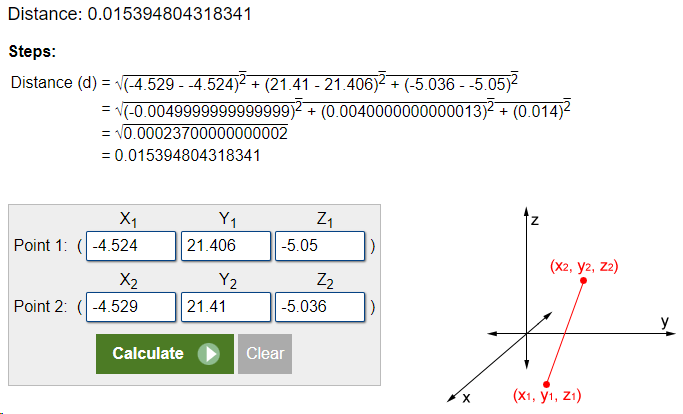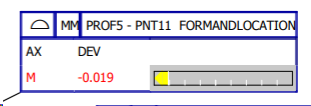I wanted to check the coordinates of our measurement and thus required a detailed log of the process from the operator. I am assuming that THEO and ACTL values are theoretical and actual coordinates of the points. Also checked if my assumption is true on Nexus Hexagon docs.
Anyways, I started to calculate the distances between the THEO and ACTL coordinates. Then compared to the ones given as profiles on the report.
PNT11 =FEAT/CONTACT/VECTOR POINT/DEFAULT,CARTESIAN
THEO/<-4.524,21.406,-5.05>,<0.2517976,0.1223556,-0.9600141>
ACTL/<-4.529,21.41,-5.036>,<0.2517976,0.1223556,-0.9600141>
TARG/<-4.524,21.406,-5.05>,<0.2517976,0.1223556,-0.9600141>
SNAP=NO
SHOW FEATURE PARAMETERS=YES
SURFACE=THICKNESS_NONE,0
MEASURE MODE=NOMINALS
RMEAS=NONE,NONE,NONE
AUTO WRIST=NO
GRAPHICAL ANALYSIS=NO
FEATURE LOCATOR=NO,NO,""
SHOW CONTACT PARAMETERS=YES
AVOIDANCE MOVE=BOTH,DISTANCE=0
SHOW HITS=NO
MOVE/CLEARPLANE

According to this calculation, i thought that my measurement should be off by 0.015 mm. However, as you can see below, the result was 0.019 mm off.

So, at this point i am curious how deviation is calculated by PC-DMIS. Can anyone care to explain?
Thanks in advance!
